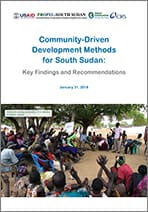News > Blog
Community-Driven Development Methods for South Sudan: Key Findings and Recommendations
Published 03/23/2018 by Global Communities

Community-Driven Development Methods for South Sudan: Key Findings and Recommendations
The USAID Promoting Resilience through Ongoing Participatory Engagement and Learning (PROPEL) program was designed to foster social cohesion and resilience in targeted communities in Jonglei, Lakes, and Eastern and Central Equatoria states in South Sudan through a Community-Driven Development (CDD) approach. The CDD approach is inclusive, ensuring representation of all community segments; transparent coordination with local leaders; targeted outreach to women; gender sensitization across the community to promote women’s voices in decision-making; strategic communication and grievance redress mechanisms throughout project implementation; and conflict-mitigation structures and capacity-building incorporated into project sustainability.
This document is intended to equip humanitarian and development practitioners with relevant techniques to achieve a do-no-harm approach to implementation in South Sudan. PROPEL’s Collaborating, Learning and Adapting (CLA) approach is critical to the goal of reducing costs and improving outcomes of interventions in South Sudan because it results in the documentation of evidence-based methods. The integration of that learning into the design of future projects, and the ongoing commitment of USAID-South Sudan to collecting, documenting and sharing lessons learned will prevent costly mistakes in future. This document is organized by issue so that content can be readily accessed, absorbed and applied by implementing partners who wish to improve the conflict-sensitivity, inclusiveness and sustainability of their program, regardless of whether they are using a CDD approach.
This document sheds light on techniques for programmatic success:
Effectively including marginalized groups in CDD programming is an effort—beyond merely ticking the attendance box—towards establishing meaningful input and civic engagement;
The value of pacing project activities to ensure full community inclusion—while balancing community expectations and donor requirements; and
Prioritizing community engagement strategies that strengthen cohesion and conflict-resolution.
To learn more read the full report.





